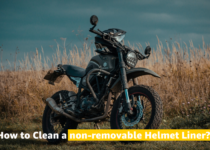DIY: Add Visor to a Bike Helmet
Mountain biking helmets have progressed in the same way as mountain bikes have. Mountain biking is a pretty new activity. It first gained popularity in the 1970s. The reason for wearing a helmet back then was to avoid injury. The riders wore heavy, heated open-face motorbike helmets. But now, it is no longer as popular as it once was. Motorcycle riders are choosing for visored helmets. So, they can ride with their shield to protect their faces. They used a form-follows-function design concept. As a result, we now have lightweight, ventilated safety helmets with visors for those who desire a visor but don’t want to spend the money on a new helmet. You can add visor to a bike helmet that the user can buy and install.

Before starting first, we need to know why do bikes have visors
Mountain bike helmets have visors to protect the rider’s safety. Often, a helmet with a visor is better than a regular bicycle helmet.
- The visor will guard your face and eyes.
If you’re biking at dawn or even when the sun is bright, you’ll want to wear a helmet with a visor. Sometimes the sun will be in front of you. Protect your eyes with a helmet that has a visor fitted to the front. Even if you’re riding in the sun’s direction, it will keep your vision clear.
- It will prevent you from the sun’s scorching heat.
Depending on the model, helmet visors can be either fixed or screwed in. Other times, the visors are detachable or molded to the helmet itself. When riding shady mountain bike paths, you can tilt the visor up. Then, when you reach an area with bright sunshine, lower the blinds. It is possible to avoid sunburn by wearing a visor that is wider than other types.
- The visor protects your face from rain, snow, and mud.
Biking in the rain or snow can be as dangerous as riding in the sun. When biking in poor or changing weather conditions, a visor provides protection.
For your eyesight to stay clear when raindrops fall on your eye, you must wipe them off with a tissue. It will also cause you to lose focus on trial. In a snowstorm, snowflakes can fall into your eyes and nose.
In a muddy trail race, a helmet’s visor can keep mud splashes from the bike’s back wheel from getting in your eyes and face. It prevents your eyes from infections.
- Prevent imbalance
Riding a bike on small hill roads and through thick forests might be challenging. The path has trees and low-hanging branches. Riders of all types take a significant danger when they pass through these areas at high speeds. Moreover, if there is no visor, the rider must grip the branches with one arm while controlling the bike with the other. As a result, they may lose their balance and be at risk for accidents. In other words, it protects riding a bike on narrow roads.
- It will prevent your eyes from dust and dirt.
Often, you’ll come upon trails where you’re riding into the wind. A helmet visor keeps your eyes and face from dust, insects, and other debris that may be flying in your way. If you’re using goggles or sunglasses with your helmet, this will also help keep them clean.
It can sting, make your eyes water, and slow you down if the weather is a little cold. A helmet visor will shade your eyes in cold, windy conditions, allowing you to ride at higher speeds.
- The visor prevents crashes and accidents.
Bike riding on single-track trails with low-hanging branches can be unsafe. Leaves, twigs, and branches might cause injury to your head if you ignore the trail. If your helmet lacks a visor, you must block such objects on tracks with your arms and hands. It could put your safety at risk. One-handed mountain bike control is impossible because you’re only using one hand. The fact that you have to pay attention to many things simultaneously is also a problem.
Having a visor on your helmet lets you concentrate on the route ahead, as it protects your head.
- It serves as a base to attach other cycling equipment.
On the helmet visor, you can attach items that will enhance your riding experience. It makes it more comfortable. To capture your trailblazing adventures, you can put a POV camera on your helmet’s visor. On the visor of your bike, you may attach an LED night light when you like to ride at night or on lit paths. You can also place goggles, strap clips, and even a storage bag on a visor if you choose.

How to add visor to a bike helmet
First, you’ll need a helmet and then a visor to protect your face. Next, you can use a skateboard helmet, which has the advantage of a very regular frontal shape. Then, you’ll need to find a visor. Motorcycle helmets with three buttons seem to be the cheap and most flexible option.
Remove the plastic shell.
The first step is to take off the decorative plastic shell. The foam of the helmet has it. It will be tape around the borders and bonded in a few areas beneath. It may not function as if your helmet is more attached. Begin by cutting or peeling the tape around the perimeter. Next, lift one end of the plastic cover and feel for the first glue dots. Break the glue connection. Be alert not to damage the plastic or pull foam parts off the actual helmet. To make this easier, use a metal shim, such as a ruler. Repeat this process for all the glue locations until the plastic cover comes loose.
Cut the nylon fabric.
Put the nylon fabric between the helmet and the plastic cover. It will act as a windproof and waterproof barrier between your head and the weather. It also traps warm air from your head and seals it in, keeping your head warm.
Dry-fit the nylon to the helmet’s foam. You don’t want to have to trim the fabric because it will compromise the waterproofness. Unfortunately, there is no way around this. Instead, it will need to fold and overlap.
Place the nylon on top of the plastic cover. Orient the fabric so that at least an inch of material protrudes from all sides. Pull the material taut with your hands, then trim around the edge with scissors. Allow at least one inch on all sides.
Glue the nylon to the surface
It’s essential to choose the correct glue for this stage. A collapsed fabric, foam is sensitive to heat and many chemicals. Hot glue is not an option for this task since it could melt the foam and set too fast. Also, they could destroy the foam. Because of this, many types of glue that include powerful solvents can also not work for this purpose. You can also use contact cement for this purpose. Foam and fabric are both porous. Thus, it makes them suitable surfaces for contact cement to attach. With a long “open time,” you can position and adjust fabric folds. Without having to worry about items becoming trapped in places, you don’t want them to.
Around where the plastic cover ends, apply glue along all ridges. Again, place the fabric on the helmet. Ensure that at least one inch of material is available on all sides. To remove some wrinkles, fold the fabric over any ample folds that are visible. Afterward, replace the plastic cover.
Pull the fabric with one hand while holding the cover in place. So that all vent holes cover the smooth and tight nylon covering. To create this look, you’ll need to fold, shift, and tuck pieces of fabric inside the cover’s ridges. In the vent openings, there will be some “waves” visible. The glue will not set if you play with it too long.
Then, for about 15 minutes, hold the plastic cover in place (if using contact cement). You should be able to peel the cover off once the glue has dried.
Glue the plastic cover
In contrast to the nylon, the plastic cover requires far less glue. A few drops here will work. You can find them in key strategic areas, for example, along the ridge on top, near vent holes, and around the sides of your vehicle. In the same manner, as when gluing nylon, press and allow the glue to cure before moving on to the following step.
Cut the remaining nylon pieces as near as you can to the edge of the plastic cover with scissors. Then, using a sharp knife, finish trimming it back to the edge. When you do this, try not to cut too into the foam.
Use an electrician’s tape or reflective tape to hide the plastic cover’s edge. Don’t stretch the tape, or it will come off and leave a sticky residue behind. Instead, press it down so that there are no bubbles or wrinkles where water can enter.
Finally, add visor to a bike helmet.
You may attach the visor to your helmet with Velcro or snap buttons that you can install with epoxy. In a shoemaker’s shop, you can find a snap of this type. But the measurements may vary according to what kind of visor you have on hand.
Like anything else, you can also measure and order online. You can plan to test out the snap button attachment soon. But for a while, you can use Velcro attachment. A slight movement is possible, but it hasn’t threatened to fall off in the past few weeks. It costs less than $15 if you already have a helmet like that.
The visor wraps around the front of the helmet from ear to ear, covering the entire front surface. As well as protecting the cheeks, it reaches downward. It attaches to the visor through a velcro strip that goes along the top. The Velcro allows you to remove the visor when not in use.
Reasons for bikes to have visors.
Mountain Bike Helmets have visors for three main reasons:
- The use of visors reduce glare from the sun while maintaining an excellent forward view
- In the case of an accident, the visor provides increased protection.
- It is not an issue for MTB riders because they travel at a slower pace than road cyclists.
Can you add visor to a bike helmet by DIY method?
You can attach only soft and flexible visors by using the DIY method. Self-adhesive and VelcroTM are the most common methods of attachment. Add-on visors are around 3 inches longer than standard visors. It depends on the product.
Related Posts

How to Clean a non-removable Helmet Liner?

Motorcycle Helmet Safety Ratings: Complete Guide







